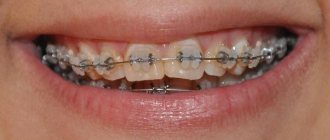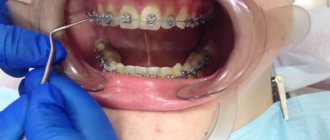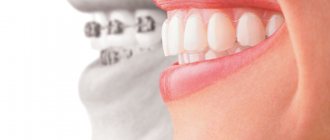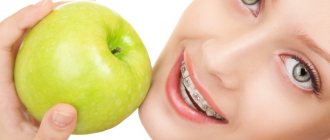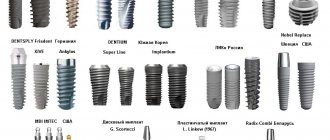Preparing teeth for braces
The presence of microprostheses, including metal and ceramic crowns, does not prevent the bite from being corrected with any brace system. Before installing a corrective system, the dentist first assesses the condition of the oral cavity, determines what type of structure is installed, and only then selects the optimal system for correcting the bite.
Correcting a bite takes a lot of time, so you first need to carry out a complete sanitation of the oral cavity. It may be necessary to replace crowns that are nearing the end of their shelf life before starting treatment. This is an important measure, because without it serious problems may arise in the future.
Crowns are placed in place of a damaged tooth to restore the aesthetic beauty of the jaw row and full chewing functions. Are braces used on dental crowns? Artificial elements do not interfere with the installation of orthodontic systems, but there are some subtleties here.
If you are dealing with a good specialist, then braces will not harm implants and crowns. They can be placed even if it is intended to move the teeth that serve as support for the bridge prosthesis. Depending on the situation, the doctor will consider two options for solving the problem.
- Completely remove the bridge and install temporary plastic crowns in its place. After treatment, the permanent dentures will be returned to their original location.
- Cut the bridge into several intervals to avoid damaging its overall structure.
If you have crowns, the orthodontist will most likely recommend metal braces, since their adhesion to the surface of the dentures is much better. Although it will still not be possible to achieve such a strong hold as with natural enamel. If you put braces on crowns, you will have to take care of your teeth. Throughout treatment, try not to put any strain on them. Avoid hard foods, toffees, chewing gum and other risk factors.
If bite correction is very important, then orthodontic structures can be placed directly on the crowns. But in some cases this leads to certain changes. How can braces affect crowns?
- If the crown was installed without removing the roots, it may unravel during treatment. If the root is removed, then the maximum that can be feared is decementing of the element.
- Before installing braces, teeth are etched with a special substance. This does not affect natural enamel at all, but on artificial material there may be slight roughness and darkening in the place where the bracket system was attached. After its removal, the surface of the crowns is carefully polished, and the mark becomes less noticeable.
- As we have already said, in some cases, permanent crowns are removed and temporary elements are installed in their place. This is a good option, but even here there may not be very pleasant consequences. Since the teeth change their position during treatment, there is a possibility that the crowns will not be able to be replaced in their original place.
So we found out that crowns, implants and fillings cannot become an obstacle to the installation of orthodontic structures. Moreover, the teeth must be put in order, treated, and all defects eliminated. What does the preparation for installing braces consist of?
- Orthodontic structures can only be placed on thoroughly treated teeth. If caries, pulpitis or other diseases are detected, they must be eliminated before installing braces.
- At the slightest sign of infection, anti-inflammatory therapy is prescribed to avoid its transition to the acute phase.
- The last stage is professional teeth cleaning with Air Flow or ultrasound. At the same stage, the doctor will give you recommendations for high-quality teeth cleaning during treatment with orthodontic structures.
DETAILS: Laser dental implantation in Volgodonsk, where to do it best.
. All dentists in Volgodonsk. In this article, we told you whether it is possible to undergo treatment with orthodontic structures if you have fillings, implants and crowns.
In conclusion, we invite you to watch an interesting video in which the dentist will tell you about the options for installing braces if there is a tooth on a pin.
Is it possible to put braces on crowns, fillings and implants?
In pediatric orthodontics, there are usually no special problems with correcting bites with braces.
Indeed, at the age of 12–13 years, after the change of the primary dentition to a permanent one, the teeth of most young patients do not have carious cavities, and the gums remain healthy.
When the need arises to correct dental anomalies in adults, the question arises: is it possible to install braces on various structures that are already present in the oral cavity in 20–30-year-old patients?
The answer to this is individual in each case. The older we get, the fewer healthy teeth we have left, and we have to use various types of prosthetics to restore the functionality of the dentition.
Therefore, modern dental technologies in most cases make it possible to straighten teeth with artificial structures installed on them using braces.
Although, of course, there are contraindications.
Is it possible to put braces on implants?
- When installing an artificial titanium root in the jawbone, the surgeon tries to fit it organically into the dentition with pinpoint precision, carefully calculating the required position in advance.
- But if at this time the patient’s bite was disturbed and the teeth were in incorrect positions, the implant, of course, will also be positioned incorrectly.
- If you install braces, then natural teeth, which retain the ability to move throughout life, will begin to move under the influence of the traction of the orthodontic arch.
But the artificial root can simply come out of the bone as a result of prolonged, constant load.
Therefore, if it is necessary to restore several missing teeth and there is a malocclusion, the patient must be explained that the position of the existing teeth should first be corrected, and then implantation should be carried out. But in some cases, options are possible, especially if there is no need to attach braces to existing implants.
Is it possible to put braces on crowns?
Since the root of a tooth covered with a crown remains alive, it also retains the ability to move in a given direction. But when making a decision, the orthodontist will definitely take into account the material from which the crown is made and check the strength of its fixation.
The patient needs to understand that the adhesion of the braces to artificial materials will be less reliable than to natural enamel.
Therefore, most likely, the doctor will suggest installing metal self-ligating braces - not the most aesthetic, but in this case providing the highest strength of fixation.
However, during the treatment process you will have to be doubly careful and avoid eating hard, tough and sticky foods to prevent the locks from coming off.
Is it possible to move the teeth on which the bridge rests?
It is possible to normalize the bite in the presence of a bridge prosthesis, but this will require a certain preparatory period.
- To prevent the solid structure from collapsing during orthodontic treatment, it can be cut into separate elements.
- There is another option: the bridge is removed and replaced with temporary plastic crowns during the correction.
During the treatment of patients with crowns and bridges, additional problems may arise. Thus, the surface of the crown will almost certainly change its appearance - it will become rough and darken.
Therefore, after removing the braces, it will have to be put in order - polished.
A crown removed before treatment cannot be reinstalled, because the position of the teeth will no longer be the same as at the time the impression was taken to make it.
Is it possible to put braces on teeth with fillings?
A professionally placed filling does not interfere with the alignment of teeth. Moreover, at the preparatory stage, the patient must undergo sanitation of the oral cavity, and teeth with carious cavities must be filled. This is a necessary preventive measure to prevent the spread of caries while wearing braces.
If the dentist follows the technology, modern composite compositions form a monolithic structure with dental tissues that is resistant to mechanical stress.
The problem can only appear if the bracket needs to be fixed in the sealed place. After all, the traction force created by the arc and applied pointwise can simply pull out or squeeze out the filling.
The orthodontist makes a decision in each of these cases individually.
If the teeth were filled a long time ago, using technologically imperfect dental materials, they will have to be refilled. During treatment, old fillings may not be able to withstand the increased load, and it will be almost impossible to replace them without removing braces.
| Doctor: Sudzhaev Sergey Romanovich Patient age: 25 years Diagnosis: distal occlusion, transversal incisal occlusion, crowding of the frontal sections of the upper and lower dentition, edentulous teeth 1.4;2.4;3.4;4.4. Duration of treatment: 12 months Equipment: Clarity SL bracket system | TO THE DOCTOR |
| BEFORE | AFTER |
How to find us?:
Multi-line phone:
+7
Mon-Fri from 9 to 20
Moscow, Spartakovskaya Square, 14, bldg. 2 (entrance from Baumanskaya St., 13, bldg. 3)
Source: https://studia-ulybki.ru/pro-breketi/mozhno-li-postavit-breketi-na-koronki-plombi-i-implanti/
In what situations is the installation of overbite fillings indicated?
- the upper and lower teeth differ in “dimensions”: usually when the lower ones are abnormally large,
- unilateral or bilateral crossbite diagnosed,
- there are disturbances in the relationship of the arches of the jaws,
- the upper incisors overlap the lower ones too much and thus come into contact with the alveoli of the palate,
- low crowns or the crowns have severe abrasion, or the edge is destroyed: in this case, the filling acts as a temporary measure that increases the height of the worn units. After treatment with braces, the tooth will need to be restored with permanent materials.
That is, all those situations of malocclusion and tooth position are described here in which there remains a risk of damage to either teeth or braces during orthodontic treatment.
What effect can bite fillings provide?
Overbite fillings remove pressure on the upper jaw, reduce the severity of pain, and also help increase the bite up to 2 mm. Following the results of the research, the use of such products allows you to achieve the desired result in a few months.
By reducing the pressure on both the upper and lower jaws, the load on the skeletal system and soft tissues is simultaneously reduced. The risk of caries and other diseases associated with the oral cavity is reduced.
Reduced load on molars increases their service life. In patients with the correct form of the dentition, the process of chewing food occurs more efficiently and quickly. Because of this, the quality of digestion also improves.
Is installation on implants possible?
Installation of braces with implants is also possible: they are not a contraindication. But there is one important point - implants cannot move into the bone. Therefore, you often have to remove them.
If you have crowns, extended teeth, fillings or implants, the installation of a brace system is carried out with special preliminary preparation. It may take several weeks, but without this the orthodontist will not begin the main work.
Preparation for installing braces on crowns includes:
- examination of the patient, determination of types of structures;
- filling existing carious cavities;
- performing radiography;
- treatment of existing pathologies of the mucous membrane;
- professional hygiene.
When there is caries or inflammation under the crown, installing braces is strictly contraindicated. Ignoring this rule will lead to the spread of infection to neighboring tissues. In 2 years (the average time of treatment with braces), you can lose not only artificial crowns, but also your own teeth.
The dentist makes the decision to install braces on orthopedic structures individually. In some cases, this procedure can lead to dental problems.
Complications that may arise when installing braces on a prosthesis:
- if there is a healthy root under the crown, there is a possibility that it will unfold;
- if the crown was removed before installing the system, putting it back will be problematic;
- The surface of the artificial tooth may change somewhat, and roughness may appear on it.
Minor damage to the prosthesis can be eliminated by grinding, but more serious defects cannot be corrected. It should also be taken into account that the position of the teeth will constantly change during treatment, and by the end of the course the prosthesis may no longer be suitable.
How overbite fillings are installed
With braces and bite fillings, the first step is to carry out a system of measures to prepare the oral cavity (sanitation). For each patient, sanitation has a different number of stages. This will depend on the degree of neglect of the oral cavity.
The installation is divided into several stages.
Elimination of caries
Caries creates a comfortable environment for the proliferation of bacteria and harmful microorganisms. It also makes it difficult to maintain oral hygiene within the required limits. Getting rid of caries when installing a system of braces and bite fillings allows for a less expensive correction at the end of treatment.
The inflammatory process creates serious discomfort after installing a braces system. Such troubles should be eliminated simultaneously with caries. Carrying out such a preparatory stage will not only improve the quality of wearing the system, but will also make the process of installing braces and bite fillings less expensive.
Teeth cleaning
With braces and bite fillings, installation occurs exclusively on the clean surface of the teeth. Clean teeth ensure better grip and good hygiene, which reduces the risk of infection during braces.
With the use of substances containing fluoride, as well as ultrasound, cleaning the oral cavity takes from half to one hour. You should not brush your teeth and install braces on the same day; it is best to take a break of several days. The reason for this is possible bleeding of the gums, which is often a consequence of cleaning the mouth.
This procedure must be performed to ensure straight teeth. If you do not remove some chewing elements, then the process of forming an even row will not work, since there is not enough space for this. Wisdom teeth (eights) must be removed. If they are left, the oval of the face may be disrupted after correction.
If necessary, it is possible to remove teeth after installing braces or fillings. I remove the system, remove the required tooth and install the braces in place. The correction process from such removal remains unchanged.
For what period of time are they installed?
In appearance, they resemble ordinary temporary fillings, only they are larger in size. Depending on what effect needs to be achieved and what features the patient’s jaw has, the doctor chooses an onlay made of one material or another. The most important property is that this element does not damage tooth enamel, but is used as a buffer, but at the same time is strong enough to withstand mechanical stress during chewing. Let's look at the materials that are used for these purposes:
- dentin: it is made from powder - zinc sulfate and zinc oxide, which is mixed with distilled water to achieve the desired consistency. Then this paste is applied to the crown of the tooth, where the material hardens,
- dentin paste: this shock-absorbing agent differs from artificial dentin in that instead of water, oil is used to mix the mass to achieve an antiseptic effect,
- Cement: This stronger material can withstand heavy chewing loads, but it is also not so easy to remove from the crown after wear. Most often, doctors use either polycarboxylate or zinc-phosphorus cements for temporary lining.
- polymers: outwardly resembles a rubber elastic layer, but at the same time provides good adhesion to tooth enamel. The polymer temporary overlay does not require special treatment; it hardens under the influence of special light rays. It is also quite easy to remove from the tooth after use.
DETAILS: What to do if your teeth move apart after wearing braces
The fillings themselves are temporary; as for the materials from which they are made, they wear out within a few months, after which, if necessary, the doctor applies them again. The material is finally removed after the teeth are in the correct position, or together with the removal of the braces system itself.
There is definitely no reason to worry about this. The fillings are made of safe material - they do not injure the stomach and intestines, and will not lead to intoxication and poisoning.
The only thing you need to do if such a situation does occur is to see your doctor, otherwise if the integrity of the filling is damaged, it may begin to crumble and chip further. The orthodontist will quickly correct the situation, repair, adjust or reapply the material.
Braces on filled teeth
Today is already 2 weeks since I was installed with BS. On HF completely, and on LF only up to 5, because At the time of installation, I still had the last unremoved 8 and the orthodontist said that he would install the locks after its removal and made an appointment in a month. On the HF I have locks installed on 6s and 7s (not rings!!
) and on the woofer, accordingly, the same ones will be glued. At a distance, the dentist performed an examination and found no problems. But the problem is that I have a light filling on the bottom 6, about 6 years old. And on the site I read a lot of articles about how it is fraught with gluing the bracket to the sealed part, that the tooth will not move, but the filling will crack/crumple/fall out, etc.
and that rings are usually put on such teeth. But my orthodontist is against rings, because... in practice, after removal, people are left with a number of problems with their gums and the teeth themselves due to the impossibility of proper hygiene. Please tell me, are there really such terrible consequences of gluing a brace to a filling and what does this actually entail?
DETAILS: Is it possible to install internal braces?
I am very worried!
Thank you in advance!
breket.info
Do fillings interfere?
You can put on braces if you have fillings. The quality of the material is taken into account. Modern fillings are difficult to damage by mechanical action, so they are left in place. Fillings that were installed a long time ago will have to be replaced, because under the pressure of braces they can crack or fly out.
Features of overbite fillings:
- are installed for the duration of treatment, that is, after removing the braces, they are removed without consequences for the health of the tooth enamel;
- they are attached in the area of the chewing teeth on the side of the cheek, they are invisible during a conversation and a smile;
- They are made from hypoallergenic materials, they do not harm teeth and mucous membranes.
As for filling already while wearing the system, this will be problematic. For this reason, throughout the treatment period, much attention should be paid to caries prevention.
Overbite fillings and plates are different concepts
In orthodontic practice, special plates are also actively used, which prevent the jaws from completely closing in order to avoid injury to the teeth and parts of the brace system. Unlike single linings, these are more complex designs, which include the Katz and Khurgina models. Typically such a device includes the following elements:
- an arc that connects the clasps to each other,
- a plate that helps move teeth in the desired direction,
- clasps are hooks that are fixed on the supporting teeth.
Overbite filling (Katz model) and plates are different concepts.
The plate is attached in the palatal position on the front teeth. Such a device additionally helps to relax the chewing muscles, which are often toned due to the presence of a large number of non-removable elements in the mouth. Sometimes elastic rods are used instead of clasps to secure the structure.
Reviews from real patients about wearing bite fillings
To avoid problems with installed dentures and your own teeth, you need to follow a number of rules when wearing orthodontic appliances. The orthodontist should tell you about them. The main one will be to follow basic hygiene rules, because without them other measures will be useless.
Basic oral care while wearing braces is as follows:
- to clean structures, use special brushes and mono-tuft brushes;
- clean at least twice a day;
- rinse your mouth after every meal;
- use hygienic toothpaste;
- additionally acquire an irrigator to clean your teeth more thoroughly;
- When brushing, pay attention to the interdental spaces, removing food particles and plaque;
- Clean the braces on each side, avoiding the accumulation of bacteria and plaque;
- use fluoride-containing pastes and rinses.
Standard set
To clean braces, you need to use a V-shaped brush with a groove in the bristles. This is where you need to start cleaning your mouth. You can also use a mono-tuft brush to thoroughly process the locks of the system.
Special orthodontic brushes are also needed to care for braces. They help to thoroughly clean the surface of crowns and fillings under the structure itself. Superfloss, which is used to clean the interdental spaces, can also cope with this.
An oral irrigator is a professional hygiene product, but anyone can get one. It comes in different shapes, features and attachments. Its main task is to clean teeth and braces in hard-to-reach areas under the influence of a powerful jet of water.
After two years of wearing braces, the risk of caries increases. For this reason, it is recommended to use fluoride-containing toothpaste, as well as products with hydroxyapatite crystals, which strengthen tooth enamel.
The main stages of how cleaning is carried out:
- The front surface of the teeth is cleaned with a brush in a circular motion, then vertical. The brush is positioned perpendicularly.
- Floss cleans the surfaces between the teeth.
- The locks of the system are treated with a mono-tuft brush or brush.
- The lateral teeth are treated with a beam brush.
- The ribbed part of the brush removes plaque from the tongue, palate and cheeks.
- The mouth is rinsed with water or a fluoride mouthwash.
DETAILS: What to do if your teeth hurt from braces?
Special care for braces also includes professional cleaning by your dentist. It is recommended to carry it out every 3-4 months.
After the procedure, the patient experiences discomfort for some time due to the inability to fully chew food and impaired articulation, because he cannot close his jaws in the usual way. However, in an ideal situation (if the doctor did everything correctly), these unpleasant sensations go away after about a week.
The rules here are standard - if you wear braces, you already have to put up with them:
- Eliminate solid foods from your diet to avoid damaging your bite fillings: say no to nuts, whole fruits and vegetables, candies,
- impose a ban on crumbly and sticky foods so that the fillings do not fall out prematurely: you cannot eat cookies, toffees, chips and crackers,
- Avoid food that is too hot or too cold to avoid damaging the integrity of the materials.
At first, during the period of getting used to the structures and when feeling severe discomfort, patients on various forums advise each other to eat soups and purees, as well as dishes crushed using a blender. This is not without meaning, but still it is not worth switching to such food on an ongoing basis - the jaw system must receive a load and function fully.
Wearing time
The material of temporary fillings wears out within a few months. If necessary, the doctor applies them again. After the dental units have taken the correct position, the onlay is removed. Therefore, only an orthodontist can tell you the exact wearing time. It can range from several months to several years.
Knowing why they put onlays on teeth with braces, the patient is ready to endure discomfort for some time. It occurs only during the period of addiction and lasts about a week. It is due to the fact that a person cannot close his jaws in the usual way. This interferes with articulation and the process of chewing food.
You will have to adjust your diet. The first days you can eat purees and soups, crushed in a blender. But then it is necessary to give a full load to the dental system. In this case, you need to avoid viscous, hot and very hard foods. Fruits and vegetables need to be cut into small pieces with a knife. Caramel and nuts will have to be excluded from the diet for a while.
DETAILS: Teeth straightening with braces in Moscow
How to maintain the condition of dentures
Artificial crowns require special care. In this case, you will have to take into account both them and those related to braces. In order not to damage the structure and prosthesis while correcting the bite with your own hands, it is important to know some points.
To maintain the condition of the crowns, the following points should be taken into account:
- plastic elements can absorb food coloring, which will affect the appearance;
- solid foods can damage them, so you should avoid crackers, nuts, and tough meat;
- viscous sweets can also damage both the orthodontic structure and the elements of the prosthesis, and also lead to loss of fillings;
- High temperature foods can cause deformation of braces and pain in teeth under crowns.
Before starting treatment, the dentist will determine individually whether it is possible to install braces on extended teeth, dentures and fillings based on the condition of a particular structure. The general hygiene index of the oral cavity is also taken into account. You may need to undergo extensive training before installation.
What are they for?
Very often on forums you can come across such a question as why do you need fillings with braces? People sometimes become horrified after a material is placed on the surface of a tooth that prevents them from chewing and closing their teeth as usual.
Colored bite filling on teeth
The main purpose of overbite fillings is to eliminate moments when the upper teeth, when closing, touch the structure of the braces, which leads to its deformation. In order to restore the structure, additional time and money will be required, which is unacceptable for many patients. After all, the braces system is worn for a long time, and you don’t always want to visit the dentist even more often than prescribed. In addition, teeth straightening is not the cheapest procedure. That is why the seals in question were created.
They can also be used for other purposes, for example:
- to correct the bite and shorten the treatment period;
- creating a temporary height of damaged and worn teeth; for low crowns.
This filling is temporary; later the chewing surface is restored with permanent fillings.
If all the teeth are healthy and have not been previously filled, a certain amount of material is applied to their surface, which is removed over time without any problems. Such fillings with braces are simply necessary to ensure the correct process of teeth alignment.
Yes, it can be done!
The prospects for orthodontic treatment will be fully explained and discussed before treatment begins. If you need treatment with braces, your specialist will fully evaluate your dental problems, explain your treatment options, and suggest the best option for your specific situation. If you have dentures or crowns in your mouth, there is no need to worry—these dental restorations are unlikely to break or collapse under pressure. Your orthodontist will assure you that you can easily get and wear braces without any problems.
Solving some problems using the system:
Is it allowed to install the system on crowns?
Crowns and bridges are permanent structures that help make a smile aesthetically pleasing for various dental defects.
You can put braces on them, but do it very carefully
. The dentist must take into account such nuances as material, strength of attachment and the presence of a root.
be divided into separate intervals while the structure is in use
so that they do not negatively affect the displacement of teeth during treatment, or
replace the entire system with a plastic one.
Important!
To prevent crowns or bridges from breaking while using an orthodontic structure, it is recommended
not to eat hard or sticky foods.
Possible complications
The dentist decides whether to install braces on crowns or not, individually for each individual case, as this can lead to the following:
- If there is a root under the crown, it can take an unexpected position under the load from braces.
- The surface of the crown may darken and become rough.
Once the braces are removed, it will need to be polished or replaced.
If the crown is removed before installing braces, it will be difficult to install it after treatment
, since the teeth will have changed their position by that time.
Can the products be installed on extended teeth?
Augmented units restored by therapeutic methods do not have such a rigid attachment as, for example, implants. For this reason, they are easy to treat malocclusion with braces and mouth guards.
However, the orthodontic design can destroy the built-up tooth.
It can be restored only after the braces are removed. The decision to install a structure in the presence of extensions is made by the treating dentist, taking into account all the nuances.
When bite correction occurs at a more mature age, many questions arise. One of the main ones is whether it is possible to put braces on crowns, implants, fillings and other dental structures? After all, the older a person is, the more various dental problems he has, which need to be taken into account on an individual basis.
In pediatric dentistry, such nuances are encountered much less frequently, because only with age do carious cavities appear, which must be healed. It also happens that a person decides to correct a defect after having already lost several units or their elements. Each nuance should be analyzed separately.
Bridges
Although a crown can restore the appearance and functionality of existing teeth, it is not suitable for filling spaces where they are missing. Also, if they need to be removed, a bridge is often the best option.
Fixed bridges replace teeth that are no longer viable for one reason or another.
As the name suggests, a bridge-like structure “bridges” the gap between the remaining ones and replaces the missing ones. This happens by using the neighboring ones remaining as a support. Therefore, the remaining adjacent teeth are often called abutments.
Bridge prosthesis on implants:
